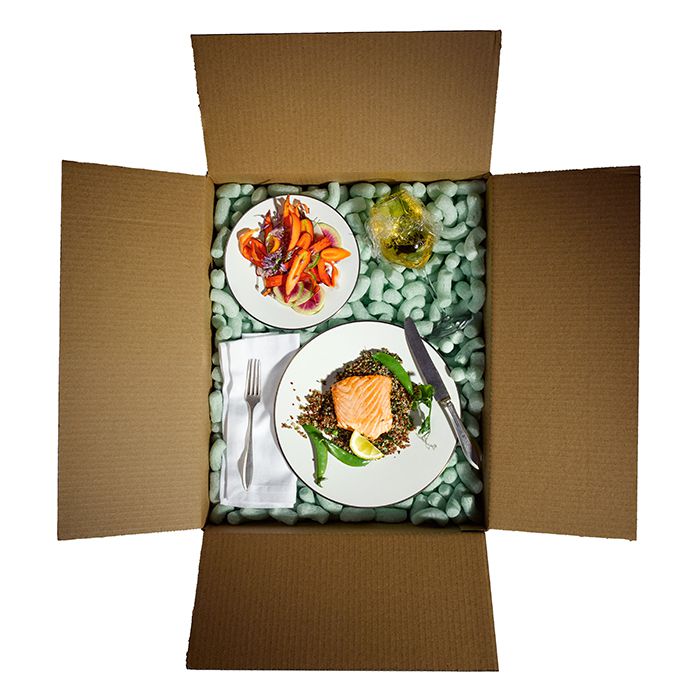
Candice Pennefather, a busy real estate broker in New York City, has enough to do without dinner being a hassle. Scouring the supermarket for ingredients, hauling grocery bags for blocks, and planning meals? That doesn’t happen. Most evenings, Candice, 33, and her husband, Nicholas, whip up dinner from Blue Apron, an online company that provides premeasured fixings for meals that are created by chefs and delivered to their door in a refrigerated box. On nights when she heads home from work, starving, at 9:30, Candice uses Seamless, a restaurant delivery service, and sushi arrives at her place as she does. To keep her kitchen stocked with basics, she clicks on items on Instacart, a grocery delivery app, so someone else can shop the aisles and carry them to her apartment building.
"When I was a kid, you could order pizza and Chinese and that was it," Candice says. "You had to have a copy of the menu, call the restaurant, and hope it got your order right. Now it's all there on your phone or tablet-you just choose what you want, plug in your credit card info, and everything is paid for before the delivery arrives. "
Welcome to Takeout Nation. At a time when supermarkets offer more choices than ever, entire TV networks are devoted to food, and we can get recipes, how-to videos, and cooking classes online, people are cooking less and ordering takeout more. And we’re talking not about burgers and fries but about gourmet restaurant meals, like coffee-rubbed kurobuta pork loin and vegetarian red coconut curry. GrubHub, an online food-ordering and delivery service that’s in 900-plus cities across the country, delivered more than 21 million orders from 35,000 restaurants to 5.6 million diners in the first three months of 2015-30 percent more than the same period the year before. “The industry as a whole does $70 billion in takeout a year,” says Abby Hunt, a GrubHub spokeswoman. “Web and mobile technology are just making it so simple. There’s huge demand for delivery.” (Learn how America’s Absurd Delivery Food Habits Are Adding Up Fast.)
Convenience is fueling the trend. "The importance of getting what you want to eat when you want it is growing," says Mary Chapman, the senior director of project innovation for Technomic Inc., a food-service research and consulting firm. "People are busier than ever and value anything that makes it easier to eat."
Today, food delivery has many different forms. Some services, like Seamless and GrubHub, deliver dishes made at restaurants. Others, like Freshly and Munchery, use their own chefs to prepare meals. The newest trend: virtual restaurants that are designed for takeout. “They don’t need an expensive location and a sexy dining room,” Hunt says. “They just need a kitchen where they can make great meals, and delivery people to get the food to customers.”
Other services are putting a whole new spin on takeout. Blue Apron, Chef’d, and Plated combine delivery and home cooking. They send you all the ingredients you need, plus step-by-step instructions, so that you can make fresh, chef-designed gourmet meals at home in less time than it would take to do it on your own. Munchery follows the same model but lets you skip the prep: Chilled food arrives at your door ready to pop into the microwave or oven. (Check out The Best Cooking Apps and Food Services to Make Healthy Meals a Breeze.)
People who work late, harried parents, and on-the-go city dwellers are key takeout customers. For some, the convenience of delivery means more than saving time. Lynsey Tracy, 36, a preschool teacher in Philadelphia, gets groceries delivered to avoid parking problems. "Finding street parking in the city is difficult," Lynsey explains. "If you get a space, you don't want to give it up to go for groceries." Instead, she used to walk six blocks to the nearest market and trudge home hauling a couple of bags, which was all she could carry. "With Instacart, I can buy more," she says. "That's a huge benefit." On GrubHub, Lynsey often orders from a favorite pizza place a block away. "It's just around the corner, but they accept cash only," she says. "GrubHub takes a credit card for the same place and includes the tip."
A better way of eating
But can all that restaurant food possibly be good for us? Researchers are just beginning to look into the health and nutrition ramifications of this brave new world of dining, but the evidence so far suggests that takeout may have real benefits. For one thing, our food choices have expanded exponentially. "Now you can get so many different options delivered to your door," Hunt points out. "You can search for Ethiopian, kosher, vegetarian, vegan, and more than 100 other cuisines." And diners in general are becoming more adventurous. "We want to try more foods," Chapman says. "We want new flavors."
Culinary curiosity is a major appeal of chef-curated recipes from ingredients-in-a-box services like Blue Apron. "Sometimes I look at the recipe card and think, 'Eh, I'm not sure I'm going to like that,' " Candice Pennefather says. "But I paid for it, so I make it, and it ends up being really good. It gets you out of your comfort zone. I didn't know what farro was until a delivered recipe showed me how to use it."
Ready-to-assemble meals and restaurant takeout may even be better for us than cooking from scratch. Recent research found no link between takeout and weight gain as long as it's not fast-food takeout. And a study published in Preventive Medicine in February showed that women who spent more time fixing their own meals were actually more likely to develop markers of metabolic syndrome, such as higher blood pressure and increased levels of blood sugar and triglycerides. "We assumed cooking at home would be healthier," says lead study author Brad Appelhans, Ph.D., an associate professor in the Department of Preventive Medicine at Rush University Medical Center in Chicago. "That's not necessarily the case, however. When you're making fabulous gourmet dishes from scratch, you may be tempted to eat more." Plus, a recipe that gives you enough food for six people makes it way too easy to serve yourself large portions or have a second helping.
Ordering your groceries online may be one way to make cooking healthier. The reason: The food is physically out of reach when you buy it. "When we're exposed to food, reward circuits light up in the brain, putting us in a state that makes it hard to resist," Appelhans explains. And the further in advance you make your eating decisions, the healthier your choices tend to be. "Looking at food online is less tempting," Lynsey Tracy says. "On Instacart, I'm searching for what I want or shopping from a list and not seeing everything else in the store."
Food delivery can even help you slim down. A recent study at the University of Connecticut found that women who ordered online groceries through the supermarket delivery service Peapod for eight weeks and also went for behavioral weight-loss therapy had healthier diet patterns than women who just did the therapy. "Those getting grocery delivery had greater reductions in the amount of food in their homes, and what they did have was lower in fat," says study leader Amy Gorin, Ph.D., an associate professor in the Department of Psychology at the University of Connecticut. The women who most frequently ordered online groceries also had the greatest weight-loss success. "Delivery can really help people stay away from impulse purchases, stick with dietary goals, and make better decisions," Gorin says.
Not only that, the time you save can also free you up to exercise. A study from Ohio State University shows that when people make their own food, they're less likely to work out because they can't squeeze fitness into their schedules. "We have approximately 45 minutes a day for these healthy behaviors, which means we don't have time to exercise and cook. We can do one or the other, but not both," says study author Rachel Tumin, a doctoral student at the university's College of Public Health.
Lynsey Tracy was pleasantly surprised to find that delivery allows her to be more active. "I had a fear that it would make me lazy, but the opposite is true," she says. "It actually gives me the time and opportunity to exercise or do something physical, like yard work."
Reality bites
As convenient as it is, takeout does have a downside. For one thing, delivery fees and minimum order amounts can make food more expensive. Restaurant services that provide healthier options tend to be found only in major cities and not in suburban or rural areas. In places where delivery apps are popular, services are often logjammed, which means that you may have to pay a premium to get your food quickly, or delivery may not even be available until the next day. Virtual grocery shopping doesn't let you pick the exact apple or avocado you want.
And meal-ingredient delivery services aren't always the great time-savers that users think they'll be. "We're pretty good in the kitchen, but it takes forever to chop all the ingredients and keep referring to the recipe card," says Blue Apron subscriber Alison Boyle, 31, of Boston. Some people also complain about the huge amount of paper and plastic waste that comes along with their orders.
Healthy to go
Despite those few hassles, most of us aren't about to stop ordering takeout anytime soon. That's fine, experts say, as long as we're smart about how we order. Here's how to best take advantage of what's available.
Get only what you need. "Delivery apps are adept at what's called suggestive selling," Chapman says. "When you place your order, they'll ask you if you want an extra side dish or if you want bacon on your salad. You end up spending more money and consuming extra calories because you keep adding on." Decide exactly what you want before ordering and stick to it throughout the checkout process.
Try new foods. Use recipe services like Blue Apron, Plated, and Chef’d to learn about unfamiliar ingredients. “People are often afraid they’ll waste time and money on a recipe that doesn’t turn out well,” says nutritionist Ayla Withee, R.D.N., the founder of the Eat Simply blog. “Recipe services help build confidence.” (See: 4 Ways to Make Dinner Easier.)
Be specific. Don't rely on grocery apps to show you everything that's available. "I used to look only at what the app offered," Lynsey says. "But you can get anything in the store if you type in exactly what you want."
Review before you buy. “Grocery shoppers in stores almost never put items back or know how much they’re spending before they check out,” Gorin says. “Online, you can reflect on whether you really want what’s in your cart.” (This tip is just one of the genius 6 Ways to Save Money On (and Stop Wasting!) Groceries.)
Use the time you gain to exercise. Ordering dinner automatically frees up your schedule. Freshly, which delivers readymade meals, claims it can save you 14 hours a week. Make those hours active.



































